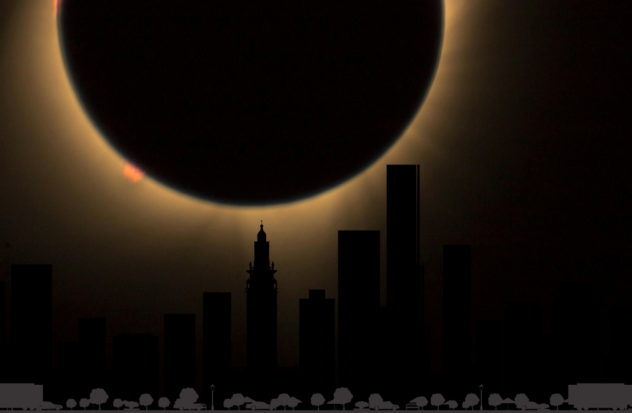MIAMI.- The day expected by many arrived. This Monday, April 8, the sky will give us an exceptional astronomical spectacle with a eclipse of total sunshine, visible in all its magnitude across different states of the United States, while in Florida will be revealed as an impressive partial display.
Although Florida is not located within the path where the eclipse will be total, residents of this state will still have the opportunity to enjoy this spectacle, seeing how the sun darkens by 57% at its maximum occultation point.
The eclipse will begin at 12:46 p.m.reaching its peak at 2:03 pm In Miami, specifically, the astronomical event will begin at 1:47 pm, culminating at 4:13 pm, with the sun experiencing an obscuration of between 46% and 56% at the peak moment, which will be at 3:01 p.m.
The Frost Science Museum in Miami will take advantage of the occasion to host a special event this Monday, complemented by a program on solar eclipses over the weekend.
Solar eclipses occur when the moon comes between the Earth and the sun, blocking sunlight.
What to keep in mind about the eclipse
It is crucial to remember that looking directly at the sun without proper eye protection can be harmful, so the use of specialized eclipse glasses is recommended.
Regarding the visibility of the total solar eclipse, it will be observable from 13 states in the United States: Texas, Oklahoma, Arkansas, Missouri, Illinois, Kentucky, Indiana, Ohio, Pennsylvania, New York, Vermont, New Hampshire and Maine, with some areas of Tennessee and Michigan that will also enjoy the full view.
NASA indicated that the best visibility of the phenomenon, along its path of totality, will extend from Mazatlán, Mexico, at approximately 11:07 am (Pacific time), to Newfoundland, Canadaaround 3:46 pm (Eastern Time).
This phenomenon expected by many will have a solar occultation duration of up to 4 minutes and 28 seconds, this time varying depending on geographic location.
For those who cannot witness this eclipse, we will have to wait until 2026 for the next total solar eclipse, then visible in Greenland, Iceland and Spain.
As for the United States, the next total solar eclipse is projected for 2044, visible only in Montana and North Dakota.
However, in 2045 a total solar eclipse is expected to cross from coast to coast across the United States, providing an exceptional opportunity for viewing across the country.





